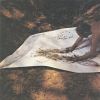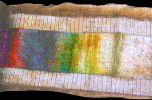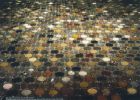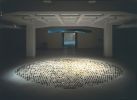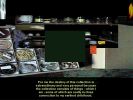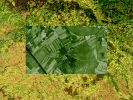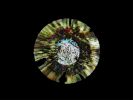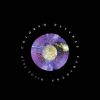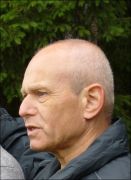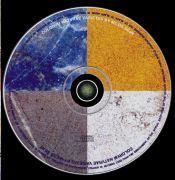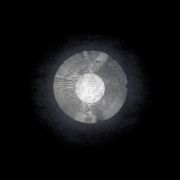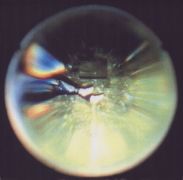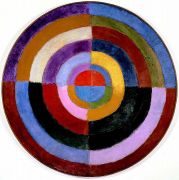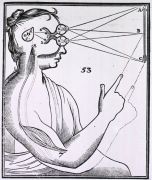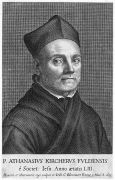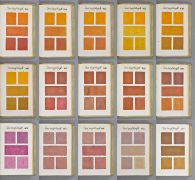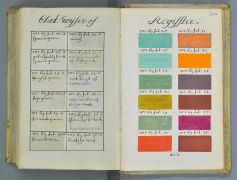The soul of man affects a kind of infinity in its objects. ... the eye is never satisfied with seeing.
John Spencer: Discourse Concerning Prodigies.
1665
And what good is it to know a multitude of things? Suppose you have learned all the circuits of the heavens and of the earth and the spaces of the sea, the courses of the stars, the virtues of herbs and stones, the secrets of nature, and then be ignorant of yourself?
Petrarch
The Museum most accurately is the place where the Muses dwell.
Claude Clements: Musei, sive bibliothecae tam privitae gram publicae extructio, instructio, cura, urus
(Lugdumi) 1635
A black, E white, I red, U green,
O blue: vowels,
I will tell you one day of your latent birth
Arthur Rimbaud: The Sonnet of Vowels.1
0. Intro
This CD ROM electronic encyclopaedia is dedicated to the investigation of phenomenology and the magic of nature, of the eye's ability to distinguish colours, and of the qualities of memory and reason to understand and denominate the visible and audible. It is conceived as a labyrinth, as well as an archive of typologies and exceptions, of chromatics, morphology and soundscapes, of the qualities of nature hidden in the internal landscape of the microcosm of the artist's personal collection. Further it is also a document of an intensive experience of the space between sound and colour, movement, written text and spoken word. It maps and represents an artist's years-long devotion to nature and to the observation of colour palettes and the morphology of events and objects. It is a diary of losing oneself in the landscape and, as well, an inquiry into the book of landscapes and the landscapes of the book. It shows the traces of the physical contact with and a record of the changeability of the surface and core of things. It brings out the sounds of listening to colours and the perception of tonal value, voices out in the landscape as well as their resonance in imagination.
I. The World at Hand's Reach or The Genealogy of the Collector and the Museum
The turn of late renaissance to the early baroque was the moment when the fascination of science and art with the multitude of details, relationships, colours and nature's elements coupled with the interest in their description and collection reached an intensity rarely paralleled in human history. Overseas voyages, colonisation and trade opened Europe to an influx of exotic objects, information, and extraordinary forms, languages and customs. New horizons, reached with the aid of technology and investigated with the new optical tools, revealed to the human eye the circuitry of the heavens as well as the intricate inner structure of matter - dissolving the medieval hermetic harmonic understanding of the world.
The surrounding world could not be but observed with different eyes. The desire to capture the image of the gradually disintegrating world in a clear and systemic encyclopaedic abbreviation - have it "at hand's reach"- gave birth not only to many works of art, buildings and volumes of books but also to the first collections of "real objects" and naturalia known from history as the wunderkamer, theatrum anatomicum or musaeum. The collections of the positivist 19th century were, obviously, incomparably more thorough and more extensive than their predecessors from the 17th century. Nevertheless the faith [vc1] at that time in the miraculous, the sacred and mutually intertwined quality of all of god's creations bolstered by the renaissance zeal for all that was new and unusual gave the wunderkamer of the 17th century, overcrowded with various products of nature, instruments and rare objects, an aura of a single complex artefact. This was an attempt at encapsulating the entire known world in an abbreviated form and putting it at the disposal of sight, touch, smell and reason. In the depositories, treatises, documents and drawings of such collectors as Ulisse Aldrovandi, Athanasius Kircher, Filipo Bonanni, William Ashworth, Giovan Battista della Porta or Francesco Calzolari are realms of the fantastic and obscure that merge the disciplines of physics, metaphysics, magic and empirical study, the fields of botany, ethnography, astronomy as well as astrology, mathematics, medicine and alchemy. This reflected that time's understanding of nature as a single all-embracing symbol, a multiplying of phenomena, forms, symbols, colours and ideas into a pantheistic, universal and infinite text. This text would be possible to comprehend with science's deciphering of the ancient and long-forgotten original language in which the divine creator wrote it during the first six days of the creation.
Based on the rigorous study of collected materials and information, the renaissance and early baroque scientists were searching for the profound relationships among phenomena and symbolic forms and constructing new images of the macro- and micro-cosmos. This was drafted in a hybrid system where experience and myth, the real and the fantastic, played equal roles.
II. Proteus and Narcissus
The Aristotelian interest in the plurality of things and the Paracelsian desire to capture the syncretic nature of the cosmic and human realms was embodied in the early collections and encyclopaedias where the real and imaginary meets the ordinary and extraordinary. Enumeration can start with: the perfect shapes of sea shells, the bizarre outfits of deep-sea creatures, the mysterious character of magnetic and oceanic currents, the colours of feathers displayed by birds imported from Africa and America. Wonder was also represented and encoded in the so-far undeciphered symbols of the Egyptian hieroglyphs; in the endless combinations of numeric columns and tables; in the petrified bones of ancient dragons; in the maps and patterns appearing on egg shells; in the odd power held by herbs, flowers and juice extracts from exotic plants; in the extraordinary behaviour of asbestos or fire; in the miraculous ability of magnets to attract metal; in the symbols of the Golden Age - the period preceding the Flood, recognisable in fossils; or in the shadow-play and illusions of then so popular laterna magica. This astonishment with the diversity of the world was the primary inspiration for the founding of many collections, cabinets, cornucopia3, gazophylacium, galleries and museums. During the transition between the renaissance and baroque, emerging museums were fulfilling the roles of contemporary laboratories, study rooms, botanical gardens, galleries and antique shops. It is interesting to follow the gradual separation, obvious in the varying attitudes of collectors, artists and scientists to the themes and material supplied by nature. The shift in vision and methodology gradually widened the gap between natural sciences and hermetic and esoteric teachings, religion and art not only in the areas of research but also in philosophy - bringing about a reconstruction of the image of the world.
For renaissance naturalists such as Aldrovandi, observing nature through the prism of findings interpreted from Aristoteles, Galenius a Plinius, was the primary motive for founding a collection to gather, recover, denote, describe and enter into a system as many elements, details and facts. The baroque collector-experimenter tried to discover the hidden mechanisms within and thus aimed to master the relationships and mysteries of processes continually occurring in Protean nature. The emblem of the early-baroque museum as well as theatre was not by chance the chameleon, and mirrors perpetually multiplied the collections of curiosities reflecting among them the shapes and faces of the collectors and pious scientists. Proteus and Narcissus were selected as the patrons of the museum and the collector. The Museum Kircherianum in the Jesuit College in Rome, for example, displayed the so-called Proteus Catoptricus installation, an optical trick through which a human head underwent a metamorphosis into an animal head. The baroque scientist emphasised the idea of nature that can be changed through active participation on the part of man, thus capable of leaving a human imprint on nature, on the phenomena once formed by the hand of the Divine Creator-Collector.
III. Anima Mundi
The look and organisation of these first naturalia collections reflected a new desire: not only to describe but also imitate natural processes, to intimate oneself with divine creativity. To demonstrate the nature of volcanic eruptions; to attempt how Atlantis collapsed; to calculate a proof of why the Babylonian Tower necessarily turned into ruins; to expose the laws of light reflection and dispersal; to illuminate the principle of sound distribution; to realise the transformation of lead into gold on scientific basis; and finally to construct a functional perpetuum mobile. This is why the new museum was becoming more an instrumentarium/exploratorium for various mechanisms that allowed such methods of handling and cognition: it hosted pumps, microscopes, telescopes, levers, grinding mortars and other optical instruments-an entire organum mechanicum serving for a betterunderstanding of but also a mastering of nature, for the penetration into the living organism as well as into the structure of minerals. For Aldrovandi, as well as for most renaissance naturalists, the collected objects were moved inside from the natural environment, conserved, named and submitted in some category as well as beheld by the astonished eye of the curious and noble public. For Kircher and his baroque colleagues, the exhibits served mainly for spectacular demonstrations, for natural experiments and the investigation of the laws of physics, chemistry and mechanics.
The wunderkamer of the baroque period, seen through the lens of the empirical science of the Enlightenment, soon became a symptom of questionable pseudoscientific presumptions, an unacceptable mixture of real facts, magic, religious dogmas and fantasy. The poetic effect and atmosphere of the wunderkamer, achieved by combining the most unbelievable objects and concepts in one space, almost disappeared during the positivist age, along with the faith that everything is interconnected and every object is in a state of potential metamorphosis into something completely different. Since the Baroque the discipline of fine arts also became quite distant from the idea of perpetual change and the transmutation of things and appearances. Old collections of minerals, insects, fauna and flora were slowly tucked away, moved away from the lapidaries of statues and galleries of paintings and exhibited in the far-away rooms of the museums. Since the mechanisation of the world, the theatrum mundi was seized upon as the singular image of the world, which was once perceived as a protean living organism, the anima mundi driven by the alchemic eternal fire. It was only 20th-century science and fine art that finally rediscovered the dusty collections of naturalia and curiosities, reviving their original poetry, giving back meaning to the exhibits of life immobilised in formaldehyde, their petrified essence stored under the glass lid of the showcase. Science is returning, although from a viewpoint and awareness different from the one once held by the baroque humanists, to the concept of nature as a singular and interconnected system.
IV. Archives
The acts of collection, denomination, cataloguing, preservation and exhibition of artefacts, products of nature and human crafts and arts, curiosities, votive objects, information and data of all kinds and origins has become almost an obsession and synonym for cultivation and civilisation for the European. It also, in a way, represents humankind's stepping into the époque of capitalism and business, of attempts to master both nature and technology, and stands as a symbol of the institutionalisation of education and the management of the civilisation process. The last two centuries witnessed the incredible development and sophistication of tools and patterns for phenomenal diversity and great plurality. Through taxonomy, the differentiation and systemisation of the universal in entities, history, society, the human soul and body, nature was laid down on a table, dissected and classified into a system of classes, races, kinds and categories. "Techno science" created a new concept of the world, comparable with and archetypal of a boundless building, an ark of sections and archives, interconnected by a network of hallways, doors, signs and names and an indexing system leading through the labyrinth. You can find here floors and departments of nebulas, planets, minerals, chemical elements, quantum physics, animals, races, machines, religions, paintings, anatomy, psychology, plants, languages and texts. Here each phenomenon, individual and object undergoes a process in which it is identified, sorted, photographed, drafted, then labelled and numbered, and finally standardised and filed in its category, group, genus and sub-genus. This process of fragmentation of the world proceeded in relation to the economic and technological changes that significantly influenced the paradigm of power, the triadic system of individual-society-nature. Archives as well as museums have become institutionalised forms of collective social memory but also of the control and manipulation of information. Access to collections, archives, knowledge and technological algorithms offers in itself a chance to gain information, insight to a deeper understanding of the nature and mechanisms of social and natural processes. But this development also creates the danger of confusion. Each piece of information, each object, image or term is stored within the mega-database in a special file whose number grows exponentially, with the headquarters hidden underground, buried in the chaos of data in the information noise. Attempts aimed at gaining a global overview of the total shape of the meta-archive, of its functioning, of the relationships between its individual directories, are more and more difficult to conceive. Human memory and its mechanical derivatives-books, archives, digital images, information networks and files, real as well as imaginary museums preserving, hiding and conserving millions of collection items, bits of information and data-are no longer just clones of nature or its mirror image. They form an autonomous, self-defined world, without direct connections to the natural world that used to be a source of legitimacy. The infinite realm of nature seemingly expands, as "techno science" opens doors to distant rooms of the macro- and micro-cosmos. At the same time, though, it inevitably diminishes and disappears as the diversity of kinds gradually yields under the influence of technology, being gradually replaced by synthetic "techno nature". Alternatives to this one way solution offering a dimension of a non-manipulative contact between humans and nature are represented by the artistic act and the capability of human mind for empathy.
The electronic miniature archive in the form of a CD-ROM Colorum Naturae Varietas was created through the interconnecting of the emotional and rational, represented by the cycles of searching, experiencing, contemplating, documenting, classifying and re-animating materials with the help of digital technology. The process separating sensual perception and abstraction characteristic of a reductive, scientific, functional approach is promoted here through synthesis, albeit a very personal view, combining the phenomena of colour, structure, action, symbol, meaning, sound and text in one organic unity. Although the CD-ROM archive's main constructive element is colour, its architecture refers to many fields-geology, biology, botany, psychology, the history of language, linguistics, semantics, gnoseology and cosmology. The realm of colours forms simply a system of orientation and resonance in this digital book on the soul of the world on the anima mundi.
V. Colours and Waves
Colour quality is a visual effect or brain function of perceiving the world allowing people and animals, apart from its practical functions, an experience of singular, sensorial dizziness, of endless diversity, as well as an emotional bonding with the landscape and the environment. In the dark, or in artificial light, we easily lose a feeling of identity, a notion of space and reality. The centre of colour perception is located in the hypothalamus, close to the areas vital for a sense of identity, authenticity, visual spatial reconstruction, movement and sight. The process of object perception starts with the dissolution of the sensory information provided by the sensation. Some neurons react to certain colours, areas are specialised for red, yellow or blue light waves, and then spatial orientation/movement/sound/touch is assessed. To interconnect all this fragmentary data and create an image that we not only "see" but also are able to "understand" presents the brain with the tough task of synchronising at one given moment all the related information in a network. According to latest research, brain communication is most likely provided by the waves known as alpha, beta, gamma and theta. Specialised devices have registered oscillation of the theta value at a time of memory centre activation, i.e. at the moment a perceived image is understood. Colour is an important quality of sensory reality, enabling understanding, the distinction of identity and the meaning of an image, thus aiding orientation with the visualisation of space and shape. Memory connects the sensorial data of vision, hearing and touch, and also associates synthetic perception: soft colours, sharp colours, deep colours, colour tones, emotional chromatics, olfactorially associated colour qualities. Surprisingly the brain's colour centre is relatively far from the speech centre, which might be the underlying reason for difficulties encountered in the comparison of these structures. Language is one of the most important abstract tools of communication, allowing us to orient ourselves in the ever-changing and chaotic sensorial environment of objects, sounds, colours, movements, actions, signs and meanings. Confronted with the breadth of the chromatic scale, the word easily bares the contingency and imprecision of its denotation. Poetry, literature as well as the scientific discipline of optics have built up their terminology and a chromatic lexicon of colour descriptions. However, the clumsiness of the word and the written text demonstrated by the delicate sensation of a colour shade, smell or sound reveals that, unlike science, the functions of the mind, as well as nature, do not know schemes, lexicons, shelves or tables. The metaphoric nature of a chromatic spectrum, affecting the comparison of a colour to an action or object, is the only consistent communication method in a colour dialogue. Eternal attempts to activate the richness and mysteriousness of the phenomenological world in its original state beyond the classifying reach of linguistic, philosophical, scientific or numeric systems represents the sublime domain of visual art. The devices of digital technology may be able to animate a static image, to enrich it with sound and text, and re-connect back data originally taken from the matrix of nature.
VI. Synesthesia and the History of Colours
The laws of perception, and the relationships among optics, colours and sounds were intensely scrutinised and researched by 17th-century humanists, during a period when most of the discoveries in this area were made, the elaboration and verification of which, however, was left to their heirs. The primary discovery and research of the qualities of the chromatic scale of a light beams bent by a glass prism, and the first consistent theory of the seven elementary colours and the colour disc is justly ascribed to Sir Isaac Newton. However the Jesuit poly-historian Athanasius Kircher also collected in his Great Book of Light and Shadow (Ars Magna lucis et umbrae (1671) an incredible number of findings and experiments related to optics, the obscurity of which ensured him a lasting name in the history of science and art. Light and colours were, in his opinion, of material nature he attempted to mechanically divide a light beam into individual colour elements and was played with the possibility of synesthesia and colour hearing. He discussed the field of sound and music in his acoustic encyclopaedia titled Musurgia (1668). In the tradition of natural philosophy, the theory of colours occupied even J. W. Goethe who also analysed them. At the beginning of the 19th century, Thomas Young discovered that colours do not represent immanent qualities of light, but are instead the result of a process applied by the sensory apparatus of human vision. He analysed the three primary colours and claimed that they are synthesised in the brain. This theory was later elaborated on in more detail by Herman Ludwig Helmholz who, while rejecting the theory of the so-called tri-chromatic brain receptors, contributed to the development of methods for the exact research of the optics of vision, the perception of colour and the relationship between the aural and visual. In 1849, James Clark Maxwell, working in the Edinburgh laboratory of James David Forbes, noticed that a fast-rotating disc with areas of primary colours creates a synthetic image of grey. He developed a concept to explain the relations between the visual perception of colours and the undulation of light radiating at the retina. This empirical finding implied that the surrounding world is not as colourful as it seems to us, and that the phenomenon of colour gaiety is a quality belonging to the physiognomy of human sight, thought-process and perception apparatus. In the 20th century, the perception of colours, their emotional charge, symbolic values, and the cultural context that influences them became a subject of experimentation and research at many institutions, and for scientists and theoreticians in the areas of physics, psychology, neurology and cultural anthropology. The need for an exact taxonomy of colours and relations between colour shade, colour denomination and colour location in a universal visual system was answered by Albert Munsell in 1905. His three-dimensional chromatic model serves as a standard scale containing fine tonal colour values from cold to warm shades and from light to deep tones. The topic of sensory induction between sound and colour, and, in part, touch, is discussed in a wide range of publications (for List of References see Chapter V below).
A brief introduction to the phenomenon of synesthesia is presented by Lawrence E. Marks and John B. Pierce in a publication titled Colored-Hearing Synesthesia: Cross-Modal Translations of Sensory Dimensions (published by Foundation Laboratory and Yale University).
Miloš Vojtěchovský, curator / organizer
Bohemiae/Czech Republic, 1999
Bibliography:
Findler, Paula. Possessing Nature: Museum, Collecting and Scientific Culture in Early Modern Italy. (Berkeley, Los Angeles, London: University of California Press, 1994)
Yates, Frances A.: The Art of Memory. (Chicago: Chicago University of Chicago Press, 1966)
Godwin, Joselin. The Theosophical Enlightenment. (Albany. N.Y.: 1994)
Godwin, Joselin. Anastasius Kircher: A Renaissance Man and the Quest for Lost Knowledge (London: Thames and Hudson, 1979)
Translated from Czech by Vera Chase


